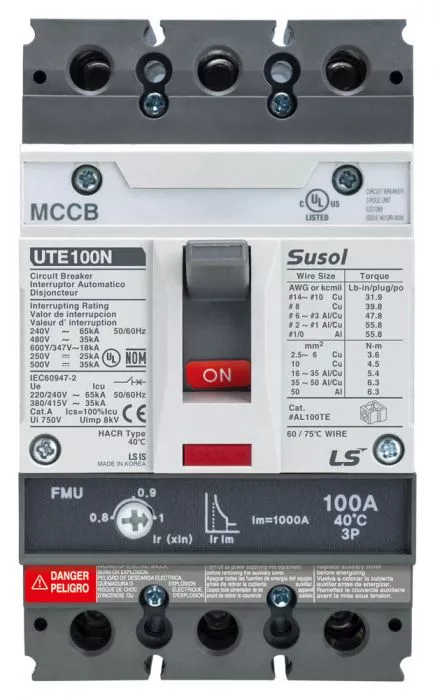The selection of any low voltage circuit breaker, for any given duty, is ultimately based on an assessment of its ability to perform the following basic functions:
- To carry the required full-load current without overheating,
- To switch and isolate or disconnect the load from the source,
- To interrupt any possible abnormally high operating current or short-circuit current, and
- To be able to perform these functions over an acceptably long period of time under the operating and environmental conditions.
Selecting a low voltage circuit breaker requires careful consideration of various criteria to ensure safety, functionality, and compliance with relevant standards. Listed below are the selection criteria to consider.
1. System Voltage
The circuit breaker should be rated for the system's voltage. In low voltage systems, this is typically less than 1,000 volts (commonly 230V, 400V, or 600V).
2. Rated Current (In)
The rated current is the maximum continuous current that the breaker can handle without tripping. This must match or exceed the load current of the circuit.
3. Breaking Capacity (Icu/Ics)
Ultimate breaking capacity (Icu):
The maximum fault current the breaker can interrupt without being damaged.
Service breaking capacity (Ics):
Typically a percentage of Icu, representing the current the breaker can interrupt multiple times without losing performance.
The breaking capacity should be higher than the prospective short-circuit current at the installation point.
4. Type of Circuit Breaker
Molded Case Circuit Breakers (MCCB):
Provide high current ratings, suitable for industrial and commercial applications.
Miniature Circuit Breakers (MCB):
Suitable for lower current ratings and typically used in domestic or small commercial installations.
Residual Current Circuit Breakers (RCCB or RCD):
Used to protect against earth faults and electrical shocks.
Air Circuit Breakers (ACB):
Used in large electrical systems where higher voltage and currents are involved.
5. Number of Poles
Single-pole:
Protects only the phase conductor.
Two-pole:
Protects both phase and neutral conductors.
Three-pole:
Protects three-phase systems.
Four-pole:
Protects three-phase systems with neutral.
6. Trip Characteristics
Circuit breakers come with different tripping curves (B, C, D) to handle different types of loads:
B curve:
For resistive loads like lighting (trips at 3-5 times the rated current).
C curve:
For inductive loads like motors (trips at 5-10 times the rated current).
D curve:
For highly inductive loads (trips at 10-20 times the rated current).
7. Operating Mechanism
Choose between manual, automatic, or remote-controlled mechanisms based on application and safety needs.
8. Environmental Conditions
Consider ambient temperature, humidity, and altitude, as these factors may affect the breaker’s performance.
For harsh environments, select circuit breakers with appropriate ingress protection (IP) ratings.
9. Standards and Certifications
Ensure the circuit breaker complies with local and international standards (IEC 60947 for MCCB/ACB, IEC 60898 for MCBs).
Check certifications from reputable agencies (UL, CE, etc.) for reliability and safety.
10. Coordination with Other Protection Devices
Select breakers that can be coordinated with upstream or downstream protective devices to avoid unnecessary outages.
11. Additional Protection Features
Overload protection:
For gradual load increases.
Short-circuit protection:
For instant high fault currents.
Earth fault protection:
For leakage to ground.
Arc fault protection:
For detecting arc faults in the system.
Remote monitoring:
In modern smart grid systems, circuit breakers with communication capabilities may be required.
12. Space and Installation Considerations
Ensure the circuit breaker fits into the designated switchgear or panel and that enough space is available for operation, maintenance, and ventilation.
